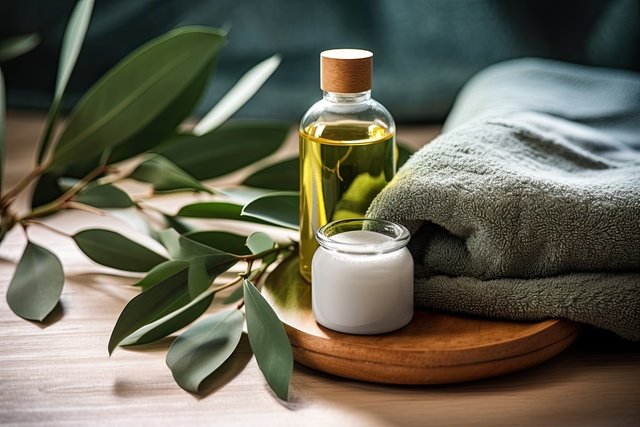Headaches come in various forms, from tension headaches and migraines to sinus pressure and cluster headaches. Each type of headache has unique causes and symptoms, requiring different approaches for relief. While essential oils are a natural and effective remedy for headaches, selecting the right oil depends on the type of headache you’re experiencing. For example, peppermint oil may work wonders for tension headaches, but a blend of eucalyptus and tea tree oil may be more suitable for sinus headaches.

In this article, we’ll dive into the best essential oils for each headache type and explore how to use them safely and effectively. Understanding the nuances of each headache type and matching it with the right essential oil can provide targeted relief and help you manage pain naturally.
How to Choose the Right Essential Oils for Different Types of Headaches: A Complete Guide
1. Essential Oils for Tension Headaches
What are tension headaches?
Tension headaches are the most common type of headache, often caused by stress, poor posture, or muscle tightness in the neck and shoulders. These headaches typically present as a dull, aching pain around the forehead or at the back of the head.
Best essential oils for tension headaches:
- Peppermint oil: Known for its cooling and soothing properties, peppermint oil helps relax tense muscles and relieve headache pain. Its menthol content also improves blood flow to the area, offering immediate relief.
- Lavender oil: Lavender’s calming and sedative properties make it ideal for easing tension headaches caused by stress. It can also help reduce anxiety, which is often a trigger for tension headaches.
- Rosemary oil: With its analgesic and anti-inflammatory properties, rosemary oil is effective for reducing muscle tension and pain, making it ideal for headaches linked to neck and shoulder stiffness.
How to use essential oils for tension headaches:
- Topical application: Dilute 2-3 drops of peppermint or lavender oil in a carrier oil like coconut oil, and apply it to your temples, forehead, and neck. Massage gently to relieve muscle tension.
- Aromatherapy: Add 3-4 drops of lavender or rosemary oil to a diffuser, allowing the calming aroma to fill the room and reduce stress-induced headaches.
2. Essential Oils for Migraines
What are migraines?
Migraines are intense, throbbing headaches often accompanied by nausea, vomiting, and sensitivity to light or sound. These headaches can last anywhere from a few hours to several days, severely impacting daily life. The exact cause of migraines is not fully understood, but they are often triggered by hormonal changes, certain foods, or environmental factors.
Best essential oils for migraines:
- Peppermint oil: The cooling effect of peppermint oil can help numb pain and reduce the severity of migraines. Its menthol content also relaxes muscles and eases pressure on blood vessels.
- Lavender oil: Lavender oil is especially effective for migraines linked to stress or insomnia. It has both pain-relieving and calming properties, helping to reduce migraine intensity and promote relaxation.
- Frankincense oil: Known for its anti-inflammatory and grounding effects, frankincense oil can help alleviate migraine pain while also reducing anxiety and tension, which are common migraine triggers.
How to use essential oils for migraines:
- Topical application: Mix 2-3 drops of peppermint or frankincense oil with a carrier oil and apply it to the base of the skull, temples, and forehead. For added relief, massage the oil into the neck and shoulders to relieve tension that may contribute to migraine pain.
- Inhalation: Inhale lavender oil directly from the bottle or place a drop on a tissue and breathe deeply. You can also diffuse lavender or frankincense oil in your bedroom to create a relaxing atmosphere during a migraine attack.
3. Essential Oils for Sinus Headaches
What are sinus headaches?
Sinus headaches occur when the sinuses become inflamed or congested, causing pressure and pain around the forehead, cheeks, and eyes. They are often accompanied by other symptoms such as nasal congestion, a runny nose, and facial tenderness.
Best essential oils for sinus headaches:
- Eucalyptus oil: Eucalyptus is a powerful decongestant that helps open up the nasal passages, making it easier to breathe and relieving sinus pressure. Its anti-inflammatory properties also reduce swelling in the sinuses.
- Tea tree oil: With its antimicrobial and anti-inflammatory effects, tea tree oil can help fight sinus infections and reduce sinus pressure, providing relief from sinus headaches.
- Peppermint oil: Peppermint oil’s menthol component helps clear nasal passages and soothe sinus pressure, making it a great option for sinus headaches.
How to use essential oils for sinus headaches:
- Steam inhalation: Add 2-3 drops of eucalyptus or tea tree oil to a bowl of hot water. Cover your head with a towel and inhale the steam for 5-10 minutes. This helps clear congestion and relieve sinus pressure.
- Topical application: Dilute peppermint oil with a carrier oil and apply it to your temples and chest to help open up the nasal passages and relieve pressure. Avoid applying essential oils directly to the nose or eyes, as this can cause irritation.
4. Essential Oils for Cluster Headaches
What are cluster headaches?
Cluster headaches are extremely painful headaches that occur in cycles, with multiple attacks happening over a period of days or weeks. The pain is usually intense and localized around one eye or side of the head. Cluster headaches are rare but can be debilitating for those who experience them.
Best essential oils for cluster headaches:
- Peppermint oil: The cooling effect of peppermint oil helps soothe the intense pain of cluster headaches. Its ability to relax blood vessels and improve circulation can reduce the frequency and severity of attacks.
- Lavender oil: Lavender’s calming properties can help reduce the pain and anxiety associated with cluster headaches, making it easier to cope with these painful episodes.
- Helichrysum oil: Known for its anti-inflammatory and analgesic properties, helichrysum oil can reduce inflammation in the head and alleviate the severe pain associated with cluster headaches.
How to use essential oils for cluster headaches:
- Topical application: Dilute peppermint or helichrysum oil in a carrier oil and apply it to the affected side of the head, focusing on the area around the eyes and temples. Gently massage the oil to promote relaxation and pain relief.
- Inhalation: Inhale lavender oil directly from the bottle or diffuse it in your room to create a calming environment that may help prevent or lessen the intensity of cluster headaches.
5. Essential Oils for Hormonal Headaches
What are hormonal headaches?
Hormonal headaches, including menstrual migraines, are linked to fluctuations in hormone levels, particularly estrogen. They often occur before or during menstruation, pregnancy, or menopause and can present as throbbing or dull pain, usually on one side of the head.
Best essential oils for hormonal headaches:
- Clary sage oil: Clary sage is known for its hormone-balancing properties and can help relieve headaches caused by hormonal fluctuations. It’s especially beneficial for headaches related to menstruation or menopause.
- Lavender oil: Lavender oil’s calming and pain-relieving effects make it ideal for managing hormonal headaches. It also helps reduce anxiety and promote sleep, which can be affected by hormonal changes.
- Geranium oil: Geranium oil supports hormonal balance and reduces inflammation, making it an effective remedy for hormonal headaches and migraines.
How to use essential oils for hormonal headaches:
- Topical application: Mix 2-3 drops of clary sage or geranium oil with a carrier oil and apply it to your temples, neck, and abdomen. Massaging the oil into your lower abdomen can also help alleviate menstrual cramps that often accompany hormonal headaches.
- Aromatherapy: Diffuse lavender or clary sage oil in your living space to create a calming environment that can help prevent or reduce the severity of hormonal headaches.
Conclusion:
Choosing the right essential oil for your headache type can make a significant difference in the speed and effectiveness of your relief. Whether you’re dealing with a tension headache, migraine, sinus headache, or cluster headache, essential oils like peppermint, lavender, and eucalyptus can provide targeted pain relief and support your overall well-being.
By understanding the specific causes of your headaches and how different essential oils interact with your body, you can create a personalized headache relief routine that uses the power of aromatherapy to manage pain naturally and effectively.

















